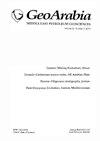Structural evolution of Jabal Qumayrah: A salt-intruded culmination in the northern Oman Mountains
引用次数: 18
Abstract
The Jabal Qumayrah area of the northern Oman Mountains records the evolution and subsequent destruction of a Mesozoic passive continental margin in the Oman segment of the Neo-Tethys Ocean, followed by the re-establishment of a passive margin, punctuated by phases of Tertiary compression. Almost uniquely along the Oman Mountains, it also contains intrusions of salt. Detachment of oceanic sediments and volcanics during the early phases of NE-directed subduction beneath the nascent Semail Ophiolite created an in-sequence stack of imbricated thrust units comprising distal trench units (Haybi Complex), and deep-ocean and continental rise sediments derived from the Mesozoic Oman margin (the Hawasina Complex). These were emplaced onto the depressed margin beneath and ahead of the ophiolite during its obduction in the Cenomanian– Coniacian. The Mesozoic continental slope sediments of the Sumeini Group had already been largely over-ridden by the more distal thrust sheets when the Hawasina sole thrust propagated into those sediments. This detached a Sumeini Group thrust sheet, which was transported westward for at least 7 km, carrying with it the overlying Hawasina thrust stack. Structurally lower parts of the Hawasina thrust stack (Hamrat Duru Group) also extended ahead of the Sumeini Group thrust sheet, but they were not restacked with it, indicating motion continued along this part of the Hawasina sole thrust. Further footwall collapse detached at least one more imbricate within the Sumeini Group and the combined thrust stack was then folded along a N-S axis, possibly above a frontal ramp. This was associated with complex out-of-sequence forward and back-thrusting at the lower structural levels. A right-lateral scissors fault developed at right angles to the direction of nappe transport, associated with normal faulting down-to-south. Late-stage culmination within the nappe pile created an asymmetrical west-facing dome, around which the structurally overlying Hawasina thrust sheets are folded. Passive margin sedimentation was re-established in the Campanian–Maastrichtian following subsidence of the locally emergent nappe pile and was dominated by carbonate sedimentation with little clastic input from the ophiolite or Hawasina sediments. Stable sedimentation persisted until Oligocene–Miocene compression, synchronous with the Zagros compressional event in Iran, resulted in west-facing folding along the western side of the northern Oman Mountains and their subsequent uplift. The Jabal Qumayrah massif preserves a salt intrusion composed of gypsum and anhydrite, the top of which is now exposed in the centre of the culmination. The origin of the salt remains unclear and investigations continue. Possible sources include the extension of the major regional salt basins found in the foreland, in particular those at the Ediacaran/Cambrian boundary (Ara Group), beneath the Hawasina Nappes and Semail Ophiolite. Alternatively, evaporitic basins may have developed locally along the edge of the proto Neo-Tethyan margin during the earliest rifting phase, beneath what became the continental slope deposits, although there is little evidence for these elsewhere in the autochthonous shelf succession.库迈拉山的构造演化:阿曼山脉北部的盐侵高潮
阿曼山脉北部的Jabal Qumayrah地区记录了新特提斯洋阿曼段中生代被动大陆边缘的演化和随后的破坏,随后是第三纪挤压期被动大陆边缘的重建。沿着阿曼山脉,它几乎是独一无二的,它也含有盐侵入。在新生的Semail蛇绿岩下,在ne向俯冲的早期阶段,海洋沉积物和火山的分离形成了一个序叠瓦状冲断单元,包括远端海沟单元(Haybi杂岩)和来自中生代阿曼边缘的深海和大陆隆起沉积物(Hawasina杂岩)。它们位于蛇绿岩逆冲期蛇绿岩前面和下面的凹陷边缘。苏梅尼群中生代陆坡沉积层在哈瓦西纳底逆冲作用进入苏梅尼群沉积层时,已被较远的逆冲层覆盖。这分离了苏梅尼群的一个逆冲板,带着上覆的哈瓦西纳逆冲堆向西移动了至少7公里。哈瓦西纳逆冲构造的下部(Hamrat Duru群)也在苏梅尼群逆冲构造的前面伸展,但并没有与苏梅尼群逆冲构造重新叠置,表明哈瓦西纳底逆冲构造的下部继续运动。进一步的下盘坍塌使苏梅尼群内至少又剥离了一块瓦覆层,然后组合的逆冲叠层沿着N-S轴折叠,可能位于前缘斜坡上方。这与较低构造水平复杂的逆冲和逆冲有关。与推覆体输运方向成直角的右侧剪断发育,与南下的正断裂有关。推覆体内的晚期高潮形成了一个不对称的朝西圆顶,其周围是构造上覆的Hawasina逆冲板。坎帕尼亚-马斯特里赫特地区在局部突出推覆体沉降后重新建立被动边缘沉积,以碳酸盐沉积为主,蛇绿岩或哈瓦西纳沉积的碎屑输入较少。稳定的沉积作用持续到渐新世-中新世挤压,与伊朗Zagros挤压事件同步,导致阿曼北部山脉西侧向西褶皱及其随后的隆升。Jabal Qumayrah地块保留了由石膏和硬石膏组成的盐侵入物,其顶部现在暴露在高潮的中心。盐的来源仍不清楚,调查仍在继续。可能的来源包括在前陆发现的主要区域性盐盆地的扩展,特别是在埃迪卡拉纪/寒武纪边界(Ara群),在Hawasina推覆体和Semail蛇绿岩之下。另外,蒸发盆地可能在最早的裂谷期沿着原新特提斯边缘的局部边缘发育,在大陆斜坡沉积物的下面,尽管在本地陆架演替的其他地方几乎没有证据表明这些盆地。
本文章由计算机程序翻译,如有差异,请以英文原文为准。
求助全文
约1分钟内获得全文
求助全文
来源期刊

Geoarabia
地学-地球科学综合
自引率
0.00%
发文量
0
审稿时长
>12 weeks
期刊介绍:
Cessation. Published from 1996 to 2015, GeoArabia, The Journal of the Middle Eastern Geosciences was a quarterly journal covering the petroleum geosciences in the Middle East. The journal covers subjects such as: - sedimentology - tectonics - geophysics - petroleum reservoir characterization
 求助内容:
求助内容: 应助结果提醒方式:
应助结果提醒方式:


